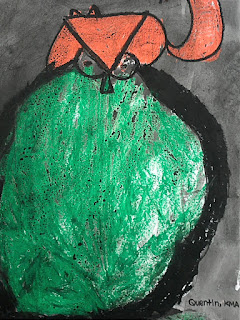4 Class Periods
 |
| Picasso Portraits, Third Grade Art Lesson |
Pablo Picasso (1881-1973) was born in Malaga, Spain. He learned how to paint and draw from his dad who was an art teacher. He studied art in Madrid and Paris when he was only 16 years old.
 |
| Pablo Picasso |
Picasso has created over 50,000 pieces of artwork during his life time. Some of which are the most expensive pieces in the world.
 |
| Dora Maar au Chat by Picasso sold for a record breaking $104 million dollars May of 2004. |
Picasso is the co-founder of a style of art called Cubism. Cubist artists wanted to show all sides of an object in the same picture. They would do this by twisting the perspective of the object through use of geometric shapes and abstraction.
As a class we looked closely at Picasso's Cubist portraits, but it was noted that Cubism was not the only style Picasso could paint. His large bodies of work are divided into four categories: Blue Period (1901-1904), Rose Period (1905-1907), African-Influenced (1908-1909) and Cubism (1909-1919). As important as Cubism is to art history, I wanted the students to realize that Picasso could also paint very realistic portraits, too.
 |
| Portrait of Picasso's Mother by Pablo Picasso. |
- Student's reviewed the life of artist Pablo Picasso (student's learned briefly about this artist in kindergarten). Together as a class we examined more specifically his cubist portraits.
- Together as a class we planned out a cubist portrait by drawing a frontal and profile view of a face on a paper bag.
- Using tempera paints, students painted the front side of the paper bag.
- Student continued to paint paper bag, this time completing the back and sides of bag.
 |
| Student working on painting the sides of their Picasso portrait. |
Day 4
- Students used oil pastels to pop out details on their portraits.
Examples of Student Work























































